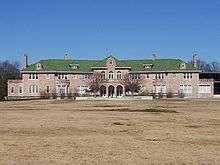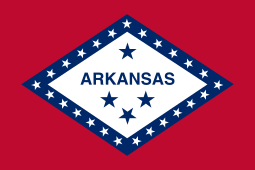Pink Palace Museum and Planetarium
The Pink Palace Museum and Planetarium in Memphis, Tennessee, serves as the Mid-South's major science and historical museum and features exhibits ranging from archeology to chemistry. Over 240,000 people visit the museum each year.[1]

The museum is part of the Pink Palace Family of Museums, a collection of historic, educational, and technological attractions maintained by the City of Memphis and Memphis Museums, Inc. The Lichterman Nature Center, the first accredited nature center in the United States, is part of the Pink Palace Family of Museums, as well as the Coon Creek Science Center, an education center which is open to organized groups and features a fossil site.[1]
The Mallory-Neely House and Magevney House are also part of the Pink Palace Family of Museums. The Mallory-Neely House is a three-story Italianate Victorian mansion built in 1852, and features 25 rooms and most of its original furnishings. The Magevney House, an 1830s cottage furnished as it might have been in 1850, is one of the city's oldest remaining residences.
The Sharpe Planetarium, housed at the Pink Palace, features 165-seat theater-in-the-round auditorium and offers public shows that project star fields, visual images, and laser lights on a domed ceiling. The Crew Training International 3D Giant Theater opened on January 21, 1995 and features a four-story high movable screen.[1] The Pink Palace Museum, the Sharpe Planetarium, and the Crew Training International 3D Giant Theater are accredited members of the American Alliance of Museums.
Pink Palace Mansion
The headquarters for the Pink Palace Family of Museums is covered in pink Georgian marble. The city of Memphis acquired the mansion when Clarence Saunders, the founder of Piggly Wiggly, became bankrupt. He had been building the residence in 1923, but lost a fortune, and the home, due to financial reversals on Wall Street.[2][3]
In March 1930, after the Stock Market Crash, Memphis Museum of Natural History and Industrial Arts opened in the mansion.[1] The original exhibits featured stuffed animals and birds, dolls, anthropological items from local wealthy collectors, as well as items related to Memphis' history, particularly Confederate military uniforms and memorabilia.
Exhibits
The Pink Palace contains a variety of exhibits relating to Memphis history. One exhibit features a replica of the original Piggly Wiggly store, the first self-service grocery store, commemorating the invention of the supermarket by Memphian Clarence Saunders in 1916.[1] Other permanent exhibits include 15th century Native American pottery, pre-Columbian artifacts, Clyde Parke's Miniature Circus, fossils and dinosaurs, and mounted animals. History exhibits focus on the roles of music and cotton on Memphis, World War I and II, the changing roles of women, historic black Memphians, and a living room decorated from the 1920s. The museum features several special exhibits each year.
Murals
The original main entrance lobby of the Pink Palace features a three-panel mural by Memphis artist Burton Callicott. The murals commemorate the discovery of the Mississippi River near the site of Memphis by the Spanish conquistador Hernando de Soto and his men, and their encounters with Native Americans. The three murals were commissioned in 1934 by the Public Works of Art Project of President Franklin D. Roosevelt's government, as part of a series of numerous art and public works projects to employ artists and others during the Great Depression.[4] Callicott, who died in 2004, taught at the Memphis College of Art.[5]
See also
References
| Wikimedia Commons has media related to Pink Palace Museum and Planetarium. |
- The Pink Palace Family of Museums Archived 2009-06-05 at the Wayback Machine, official site.
- Brooks, John (2014). Business Adventures. New York: Open Road Integrated Media, Inc. pp. 256–257, 277, 279. ISBN 9781497644892.
- Freeman, Mike (2011). Clarence Saunders & the Founding of Piggly Wiggly: The Rise and Fall of a Memphis Maverick. Charleston: The History Press. p. 63,86. ISBN 9781609492854.
- The Pink Palace Family of Museums: Burton Callicot Murals.
- Elizabeth H. Moore, "Burton Callicott," Tennessee Encyclopedia of History and Culture.






